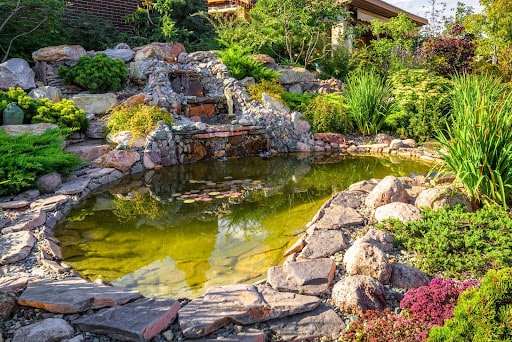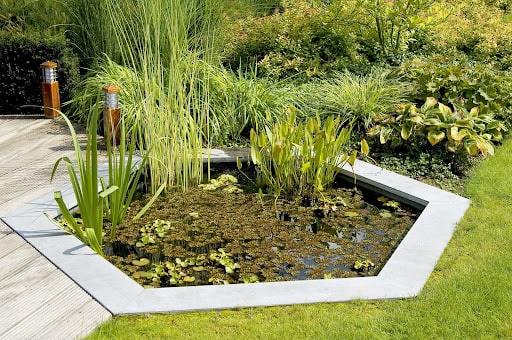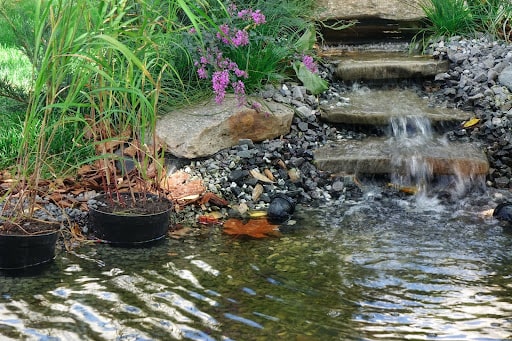Water Garden 101: Pond Ideas on a Budget

Adding a water garden to your outdoor space will no doubt add curb appeal to your home. However, like many additions to your property, it can become expensive. The good news is that there are ways anyone can build a creative water garden, without spending all of their savings.
In this blog, we’ll review everything you need to know about water gardens, including some great pond ideas on a budget that you can use for inspiration.
Water Gardens Design Tips
The first thing to think about when coming up with pond ideas on a budget is how you will design your water garden. There are a few pond basics to consider as you debate water garden designs, these include:
- Will your pond be above ground, in-ground, or partly in-ground?
- What types of materials will you use to contain, surround, and line the pond?
- Is your pond style going to be natural, seminatural, or formal?
- Where will your pond go in your backyard?
- What kinds of grasses, plants, and/or fish will you want to incorporate?
Below, we’ve outlined what you should know about the questions above. Once you’ve done some research, you’ll be able to start building any creative water garden you desire.
Pond Shapes & Types
Begin your research with the pond shape and type you’re looking to build. There are three main categories these are broken down into:
Natural
A natural-styled pond is meant to blend into the surrounding landscape. This means taking advantage of free-form edges that don’t follow a straight or predictable course and staying away from harsh corners. To complete the look, you should also incorporate plants and stones that are native to your area.
Seminatural
A seminatural pond still focuses on free-form edges, however, they’re usually set next to a concrete, stone, or brick patio. The key to this style is to include natural elements while still taking cues from the existing hardscape around the home. Feel free to use native or non-native plants and stones.
Formal
A formal style pond is the opposite of a natural one. Defined by geometric shapes and harsher edges, these ponds are the most expensive. Formal ponds are usually surrounded by mortared stone or poured concrete. The plants are sparse or non-existent, but these are popular for showing off unique fish.

Pond Location
As you consider the location of your pond, you should first think about sunlight. Ideally, ponds should receive sunlight in the mornings and shade in the afternoons. This will keep the water cooler, allowing you to avoid the risk of harmful algal blooms.
The next factor to consider is your trees. A tree’s afternoon shade can be a good thing, but placing your pond directly under branches can result in issues with clogging from leaves, seeds, and needles. This means you’d be responsible for constant maintenance.
Another good note to keep in mind is young trees that may be in the area. If you’re planning on placing a pond near a younger tree, make sure to factor in its mature spread before settling on the location.
Finally, you’ll want to think about the distance your pond is from your house. This of course will also depend on the size of your yard and/or patio. Oftentimes, a pond that’s set too far back (usually out of eyesight from the house) will end up being neglected. A good best practice is to go no further than 20 feet from your patio area.
Plants for Water Gardens
When choosing water plants for your pond, it’s important to have some understanding of which plants thrive in an aquatic environment. These can typically be broken down into 5 categories:
- Floaters- These consist of plants that float on top of the water and don’t need soil to grow. Some of these include water lettuce and water hyacinth.
- Oxygenating grasses- These grasses grow on the bottom of your pond, completely submerged. Some types include eelgrass and fanwort.
- Emergent plants- Also known as marginals, these are the plants that grow on the edge of your pond, usually 4-12 inches below the surface. Some of these include water lotus and cattail.
- Bog plants- These plants grow best on the shore of your pond with the water surface just covering the soil or slightly below the soil. Some bog plants include white rush and bog bean.
- Deep water plants- As their name suggests, these plants grow completely underwater. They need at least 10 inches of water covering the soil surface and may require a larger area. Some of these include water lilies and hornworts.
Fish for Water Gardens
Adding fish to your water garden is completely optional. However, before you decide on which fish you may or may not want to incorporate into your pond, you need to know the factors that should be considered.
Climate, as well as the depth and size of your pond, are large contributing factors to which fish will survive in your water garden environment. Another element to think about is the size your fish may grow to. Finally, you’ll want to consider pond fish care, food availability, surrounding plants, and other types of fish that may be included.
Below, we’ve outlined some of the best options for fish to add to your pond based on their water requirements.
- Comet Goldfish- 10 gallons of water for every 1 adult fish
- Shubunkin Goldfish- 10 gallons of water for every 1 adult fish
- Rosy Red Minnows- 10 gallons of water for every 6 adult fish
- Gambusia or Mosquitofish- 5 gallons of water for every 1 pair of adult fish
- Japanese Rice Fish- 10 gallons of water for every 1 school of fish
- Koi Fish- 10 gallons of water for every 1 adult fish
The prices of the fish will also vary depending on size and quantity. To get the most bang for your buck, you may want to buy your fish in pairs or threes. Many pet/fish stores offer deals for buying fish in pairs and threes rather than singularly. Also, the smaller the fish, the less it will cost.

5 Pond Ideas on a Budget
Once you have your research, you’ll be able to start thinking about pond ideas on a budget you can use. Below, we’ve shared some of our favorite backyard pond ideas for those who are trying to spend less money.
1. No-Liner Natural Pond
Water gardens don’t have to be extravagant, sometimes there’s beauty in simplicity. Creating a no-liner natural pond is not only cost-efficient but also very ecologically friendly. All you need is some Bentonite clay, which will keep the water from being absorbed into the ground, and some stones and plants of your choosing.
2. River Rock Garden Pond
Many times, homeowners already have a space that’s perfect for a small water garden. By inserting a garden pond form in an open area, you can customize your own river rock garden pond. Bagged stones or slates are relatively cheap materials, and in some areas, you can even get them for free.
3. Multi-Basin Tire Pond
Believe it or not, recycled tires can actually be a great foundation for a backyard pond. Start by getting a few (we recommend 3) recycled tires of different sizes. Outline each tire in an open area outside and dig holes according to their size. Once you put the tire down you can cut off a small part of the top and build around it.
4. Zen Container Pond
If you love Japanese water gardens but are looking for pond ideas on a budget, this zen container pond is perfect for you. All you need is a recycled container or basin, a few green succulents or plants, and a few small, smooth stones. You may even choose to add a Koi fish or two (depending on the size of your basin).
5. Low Budget Waterfall Pond
Having a lot of rocks in your garden and on your property can be annoying when you’re trying to get some yard work done, but there are ways you can put them to good use. If you’re constantly collecting rocks, consider creating a small pond with a waterfall. Without purchasing the rocks, you’ll only need to pay for a pond liner and pump.

No matter how you choose to build or design your water garden, there’s no doubt it will add visual appeal to any outdoor area. However, it’s important to remember to keep up with maintenance. This may include keeping your water clear, and of course, closing your pond for the winter.
Ready to bring your outdoor space to the next level? Check out our Home & Garden Centers to see how we can help your backyard dreams come true.
